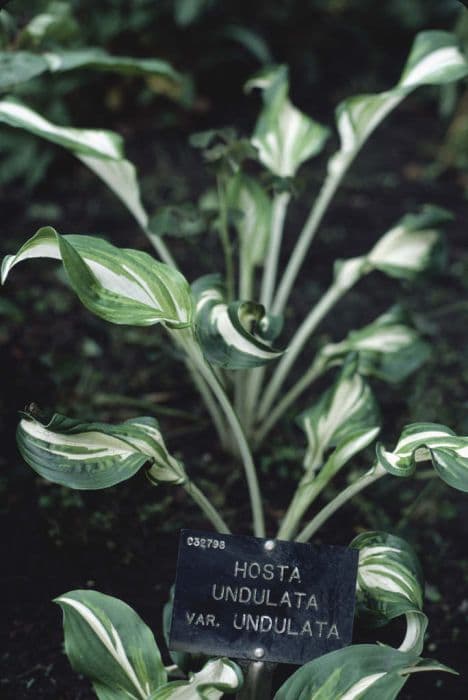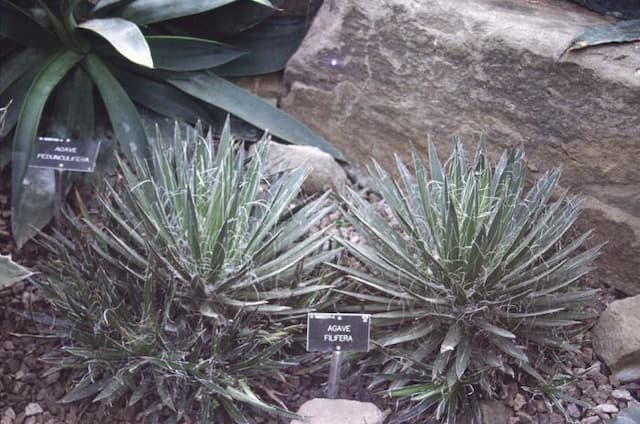Wavy-leaved Hosta Hosta undulata var. undulata (v)

ABOUT
Plantain lily is an herbaceous perennial known for its foliage. It has wavy-edged leaves that are typically variegated with a combination of green and white or yellow patterns. The leaves are broad and often heart-shaped, forming an attractive mound of foliage. The variegation can be in the form of streaks, margins, or an overall mottling. The plant also produces stalks that bear bell-shaped flowers, which can range in color from lavender to white and often appear above the foliage in summer. The Plantain lily makes for an impressive display in shade gardens, thanks to its striking leaves and charming blooms.
About this plant
 Names
NamesFamily
Asparagaceae
Synonyms
Funkia, Plantain Lily, Wavy Plantain Lily
Common names
Hosta undulata, Funkia undulata.
 Toxicity
ToxicityTo humans
Hosta, also known as plantain lily, is generally considered non-toxic to humans. However, ingestion of any part of the plant is not advised as plant material that is not intended for consumption may cause gastrointestinal discomfort. Symptoms could include nausea, vomiting, or diarrhea if large quantities are consumed.
To pets
Hostas are toxic to pets, particularly to dogs and cats. If a pet ingests any part of a hosta plant, it could lead to signs of poisoning which include vomiting, diarrhea, and depression. In some cases, ingestion can be severe enough to warrant veterinary attention. It is important to keep pets away from hostas to prevent any potential health issues.
 Characteristics
CharacteristicsLife cycle
Perennials
Foliage type
Deciduous
Color of leaves
Variegated
Flower color
Lavender
Height
1-2 feet (30-60 cm)
Spread
2-4 feet (60-120 cm)
Plant type
Herb
Hardiness zones
3
Native area
Japan
Benefits
 General Benefits
General Benefits- Ornamental Appeal: Hostas are primarily grown for their attractive foliage, which provides a lush backdrop in garden designs.
- Shade Tolerance: Hostas, including Hosta undulata, thrive in shaded areas where other plants might struggle.
- Low Maintenance: They require minimal care once established, making them ideal for gardeners who prefer low-maintenance plants.
- Variety of Uses: Suitable for borders, ground cover, or container gardening, offering versatility in landscaping.
- Tolerance to Poor Soil: Hostas can survive in less-than-ideal soil conditions, although they prefer well-drained soils.
- Longevity: Hostas are perennials, able to provide beauty for many years with proper care.
- Compatibility with Other Plants: They can be easily combined with other shade-loving plants to create a diverse garden.
 Medical Properties
Medical PropertiesThis plant is not used for medical purposes.
 Air-purifying Qualities
Air-purifying QualitiesThis plant is not specifically known for air purifying qualities.
 Other Uses
Other Uses- Hosta leaves can be used as natural platters for serving food at garden parties, providing an aesthetic and eco-friendly option.
- The large leaves of the Hosta can be employed in crafts, such as leaf-printing on fabric or paper for a unique botanical design.
- Hosta plants can be used in a rain garden setting, as they are good at absorbing excess water and helping to filter impurities.
- They can function as a living mulch, covering the ground around trees or shrubs to help retain soil moisture and suppress weeds.
- Hostas can contribute to a sensory garden due to their varied and interesting foliage textures and are particularly engaging for tactile experiences.
- When dried, Hosta leaves can be incorporated into floral arrangements or wreaths for a rustic and woodsy decorative touch.
- Hosta can be used as a natural dye source, where the leaves yield various shades of green, ideal for textile and craft projects.
- In areas prone to soil erosion, planting Hostas can help stabilize the soil with their extensive root systems.
- An educational tool for teaching botany or plant propagation techniques due to their ease of division and clear demonstration of plant growth habits.
- As a companion plant, Hostas can be used to highlight the colors and textures of flowering plants or to create contrasting forms in garden design.
Interesting Facts
 Feng Shui
Feng ShuiThe Hosta is not used in Feng Shui practice.
 Zodiac Sign Compitability
Zodiac Sign CompitabilityThe Hosta is not used in astrology practice.
 Plant Symbolism
Plant Symbolism- Devotion: Hosta, also known as Plantain Lily, often symbolizes devotion due to its lush foliage and tendency to fill garden spaces, representing a gardener's dedicated care and attention.
- Friendship: The Plantain Lily's broad leaves spreading out can be seen as an embrace, symbolizing openness, inclusivity, and friendship.
- Resilience: Hostas are known for their hardiness and ability to thrive in shade, making them a symbol of resilience and adaptability to life's challenges.
- Heartiness: As a plant that comes back year after year, the Plantain Lily represents endurance and long-lasting presence, much like a steadfast heart.
- Peace: The calming green hues and gentle undulation of Plantain Lily leaves bring a sense of tranquility and peace to any garden space.
 Water
WaterHostas require even moisture and should be watered deeply about once a week, depending on the climate and soil conditions. Provide them with roughly one inch of water each time, ensuring that the water penetrates deeply into the soil to encourage root growth. During hot or dry periods, you might need to water more frequently, while in cooler or rainy conditions, you can water less often. Overhead watering should be avoided to minimize leaf wetness and reduce the risk of fungal diseases. It's vital to maintain a consistent watering schedule to keep hostas healthy and avoid stress from drought.
 Light
LightHosta plants, commonly known as plantain lilies, thrive best in partial to full shade. They should be placed in a spot where they are shielded from the harsh afternoon sun, which can scorch their leaves. Morning sunlight is beneficial, but filtered light under trees or a northern exposure is ideal to maintain the vibrant color and health of the leaves.
 Temperature
TemperaturePlantain lilies grow well in a wide range of temperatures but prefer a climate with cool to moderate summer temperatures. They can tolerate minimum temperatures down to around 30°F before foliage dies back, and they remain dormant through the winter. The ideal growing temperature for hostas is between 50°F and 75°F, with increased humidity levels to keep them lush and healthy.
 Pruning
PruningPruning of plantain lilies is generally done to remove dead or damaged foliage and to tidy up the plants, promoting healthy growth and appearance. The best time to prune is in the late fall or early spring, cutting back dead leaves and flower stalks at the base. Pruning is not frequently required but doing it annually helps to maintain the aesthetics of the garden and can help prevent disease by removing potential fungal-breeding material.
 Cleaning
CleaningAs needed
 Soil
SoilHostas, commonly known as Plantain Lilies, thrive in well-draining, fertile soil rich in organic matter. The ideal soil mix should comprise equal parts of garden soil, peat moss, and perlite or pine bark fines. Hostas prefer a soil pH range between 6.0 to 7.5, slightly acidic to neutral.
 Repotting
RepottingPlantain Lilies should generally be repotted every 3 to 5 years or when they outgrow their current container. Division during repotting helps manage their size and rejuvenate the plants.
 Humidity & Misting
Humidity & MistingPlantain Lilies do best in a moderately high humidity environment, ideally between 50% to 70%. They can tolerate lower humidity levels but prefer consistent moisture in the air.
 Suitable locations
Suitable locationsIndoor
Keep Plantain Lilies near a bright window and maintain moist soil.
Outdoor
Plant in partial to full shade with moist, rich soil.
Hardiness zone
3-9 USDA
 Life cycle
Life cycleThe wavy-leaved hosta, Hosta undulata var. undulata (v), begins its life cycle as a seed, germinating in cool, moist soil conditions in spring. After germination, it develops into a seedling with a small rosette of leaves. As it matures, the plant grows larger, forming a clump of characteristically wavy, green leaves with white or creamy margins, and it establishes a strong root system. Yearly, from late spring to early summer, the hosta produces tall flower scapes topped with lavender or purple blooms that are attractive to bees and other pollinators. After flowering, seeds are produced and dispersed, completing the reproductive cycle. During winter, the plant enters a period of dormancy, with the foliage dying back, and it relies on energy reserves stored in its rhizomes to regrow the following spring.
 Propogation
PropogationPropogation time
Late summer
Propogation: The most popular method of propagating Hosta undulata, commonly known as Undulate Hosta, is by division. This is best done in early spring or fall when the plant is not in active growth. To propagate by division, the gardener should gently dig up the entire plant, taking care not to damage the roots. Once out of the ground, the clumps can be carefully separated by hand or with a knife, ensuring that each new section has at least one growing point or "eye." These individual sections are then replanted at the same depth they were growing before, spaced approximately 12 to 24 inches apart (30 to 61 centimeters). Water the divisions well to help establish their roots in their new location. This method of propagation allows for the maintenance of the variegated patterns and characteristics of the Undulate Hosta.









